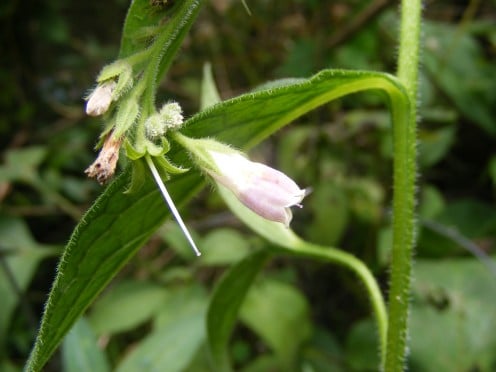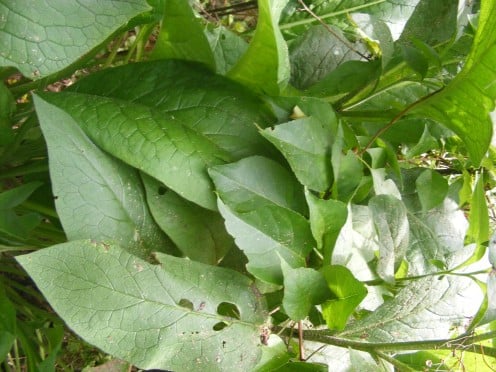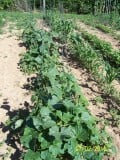- HubPages»
- Home and Garden»
- Gardening»
- Organic Gardening
Quick Plant Care Guide Grow Comfrey Symphytum Officinale
Grow Comfrey
Learn how to grow Comfrey (Symphytum officinale) plants for your homestead. An easy plant with awesome farm benefits!
Comfrey Flower

Comfrey as Permaculture Homestead Plant
- Comfrey is a fast growing, tough perennial plant. It quickly grows masses of leaves that can help create a healthy amount of compost.
- Bees enjoy its pretty, bell-shaped purple blossoms.
- One of the reasons comfrey is a good plant for any natural homestead, is the speed at which it multiplies and bounces back when trimmed for mulch. When growing organic crops, being able to create your own fertilizer is essential. If all you did was grow comfrey as a compost plant, it is well worth any trouble.
- Comfrey can be fermented in a five gallon bucket of water for a few weeks to make a tea for garden plants. Leftover comfrey sludge can be added to the compost pile.
- Comfrey shades out undesirable plants while providing desirable biomass for the garden and orchard.
- Wilted and fresh comfrey leaves can be used as a feed for many types of livestock.
- Comfrey can grow into a lovely blooming hedge. Blocking types would work well for this application as a seeding variety may try and take over.
- Established plants can be a source of income and trade for your homestead.
- Comfrey is just a beautiful, tight plant. It can form a lovely mound, almost hosta-like in appearance. Farms can be pretty, too!
Prevent Comfrey Reseeding
Comfrey can become aggressive in its spread.
Simply remove all of the blossom stems before they can set seed. Some cultivars (BLOCKING 14) do not produce viable seed.
In order to get the best spread of this variety you need to chop up the roots from time to time. Each piece of root should produce a new plant.
How to Grow Comfrey
Comfrey plants are not super picky about growing conditions. They grow in full sun or shade. More sun would probably yield better leaf growth. Mulch will help establish plants and retain moisture.
- Simply clear an area and dig down six to twelve inches.
After breaking the ground up add a few inches of compost, lay your root pieces about one to three feet apart. Cover with soil, mulch, then water well.
In sandy, dry areas like NW Florida, mulching and compost will help to establish new plants.
- Keep the new plants watered, not allowing them to dry out.
It may take a few weeks to see decent growth, especially when using root cuttings.
Do not worry, comfrey is hardy and strong.
- Do not harvest leaves right away. Allow your plants to grow for a season (solid year), in order to establish a healthy root system.
The next year after planting, you can begin harvesting leaves for use as mulch, comfrey tea, and as a compost additive.
Comfrey Plant

How I Grow my Comfrey
I plant my comfrey in more than one area--but in its OWN area. This way I can ensure it will not take over my orchards or other areas of my property.
Giving comfrey its own large garden patch, ensures that I can grow more than I need, with no worries of it taking over.
I can also chop the roots up with wild abandon and spread the plants without harming other species. Win, win.
Harvesting Comfrey
Harvesting comfrey leaves is as simple a snapping the fleshy leaves off cleanly--or using shears to remove them.
Add directly around plants whole, shredded, as comfrey tea, or compost them.
I never remove all of my comfrey leaves in one go. Leave several on the plant to help replenish the roots.
Easy Comfrey Chicken Mulch
One of the easiest ways to make a shredded compost for your gardens is to utilize your chickens. Toss loads of comfrey leaves in their pen and let them tear them up. Even if they do not eat them, they will scratch them into bits and mix the leaves with their manure.
Simply toss the old bedding on the compost heap after they have done most of the work.
This is a tried and true method of making fertilizer with many scrap plants. Chickens are workhorses when it comes to turning garden refuse into useful fertilizer.
Toss a few handfuls of feed or kitchen scraps into the heap and they will work even faster.
What Do You Think of Comfrey?
Want to Know More About Comfrey?
Just ask in the comments at the bottom of my article. I am sure I missed plenty when writing this. My Quick Plant Care Guides are meant to be short and to the point.
© 2019 Isadora








